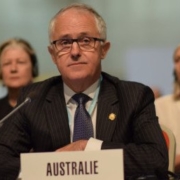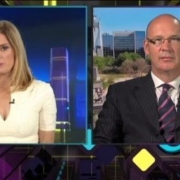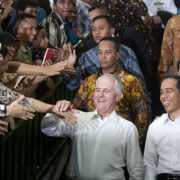
Far more tourists from Malaysia and Singapore visit Australia than from Indonesia, despite Indonesia’s much larger population. Photo by Sportourism.id
Air Asia’s slogan is “Now everyone can fly”. Indonesians seem to have taken this message to heart, as in 2017, 9.1 million Indonesian citizens travelled abroad, and more than 3 million applied for a new passport. The number of Indonesians travelling overseas is growing rapidly as this nation of 265 million people sees the emergence of a middle-class eager to take up the latest technologies, eat better food, and travel.
The favourite overseas destinations for Indonesians last year included Singapore, Kuala Lumpur, and Bangkok, as well as China, Japan and South Korea. But what about Australia? Australian statistics show encouraging growth in the inbound tourist market from Indonesia, (up 14 per cent last year) but this is from a very low base and these figures include student and business travellers.
It is important therefore to compare the number of tourists coming to Australia from Indonesia with the numbers arriving from its neighbours in Singapore and Malaysia:
Singapore: 213,000 (from a total population of 5.6 million)
Malaysia: 190,000 (population 31 million)
Indonesia: 94,176 (population 265 million)
A closer look at holiday travel to Western Australia makes a good case study. In 2017, 30,000 Indonesians came to WA yet only 12,000 came for holiday purposes. That represents 0.32 per cent of a huge market that is only 3-4 hours away.
When one considers the size of Indonesia and its strong and growing middle class, the figures for travel to all of Australia are also disappointing – we attract a mere 1.03 per cent of the market for overseas travel from Indonesia. Why?
To be fair, Tourism Australia has been negotiating with the Indonesian bureaucracy for more than three years to obtain permission to open an office in Jakarta. The Australian Embassy in Indonesia is home to many highly experienced and dedicated staff who understand the potential for increasing the number of Indonesians wanting to holiday in Australia. In Australia, however, officials from the Department of Immigration and Border Protection (now the Ministry of Home Affairs) seem happy to maintain red tape that discourages Indonesians from heading down under.
The Home Affairs Ministry has repeatedly avoided responding to questions about why Indonesians must be subjected to laborious visa application processes, pointing out that Chinese nationals are also subjected to the same visa requirements. It is possible that the ministry is concerned about violent Muslim extremism in Indonesia but it has not applied the same criterion to Malaysia, which has also been home to terrorist groups.
Only three months ago, tourists from Indonesia finally became eligible to apply for an Australian visa online. Yet they still must pay a non-refundable fee of $140 each (or $560 for a family of four) just to apply. This cost is on top of the 13 pages of questions that must be answered by each applicant.
Over Christmas, I met a family of 22 from Bandung, West Java, who were enjoying the views from Kings Park in Perth. Their host explained that it had been difficult to arrange such a large group and he the group had paid $3,080 to apply for visas and completed some 286 pages of questions. It is little wonder many Indonesians simply choose other destinations.
A new wave of tech-savvy and financially able Indonesians now seek out last minute cheap online airline tickets for long-weekend holidays in neighbouring countries. Australia misses out on this market as the process is too expensive, too slow and bureaucratic. Australia loses potentially huge tourism dollars while both nations miss out on the opportunity for their respective citizens to get know each other better.
When Indonesia removed its Visa-On-Arrival fee that was applied to all Australians heading to (mainly) Bali, it came at a cost of $50 million to the Indonesian government. The following year saw the number of Australians holidaying in Bali increase by more than 16 per cent, adding $145 million to the local economy. Imagine if Australian bureaucrats followed the Indonesian lead and issued a free visa or even applied a $20 fee – the amount that nationals from Singapore, Malaysia, Japan and Brunei now pay – to Indonesians wanting to spend their holiday and money in Australia.
Young Indonesian backpackers are also left frustrated by Australia’s determination to block them from experiencing our country as thousands of overseas backpackers from other countries do each year.
Indonesian youngsters can only obtain an initial one-year Work and Holiday visa, whereas Japanese or Singaporean nationals, for example, receive two years up front. Indonesians must also have a minimum of $5,000 in their bank accounts and obtain a letter of recommendation from their government.
Australia has recently allowed Indonesians to apply for a three-year multiple entry visa. This has pleased some but as one guest told me recently: “It is a bit like going into a supermarket for one packet of strawberries only to find they are offering a better deal if you buy three, even if you don’t want three.”
Australian political leaders repeatedly stress the importance of the Indonesia relationship but the government continues to act in a way that indicates it is not sincere. And Australia is the loser as Indonesians simply look and head north.
Despite the fact that 98.4 per cent of all Indonesian visitors to Australia last year met the requirements of their visas, we still seem determined to discourage them from coming here for a holiday.
Australia obviously seeks to keep its borders secure, but the government is also acutely aware of the need to diversify our economy away from an over-reliance on mining and residential property. Tourism is an obvious example of how we can achieve this end.
The challenge for our government and its bureaucrats is to ensure we get the critical balance between homeland security and the huge and emerging market in tourism from Asia.
At the moment we may not have that balance right.










